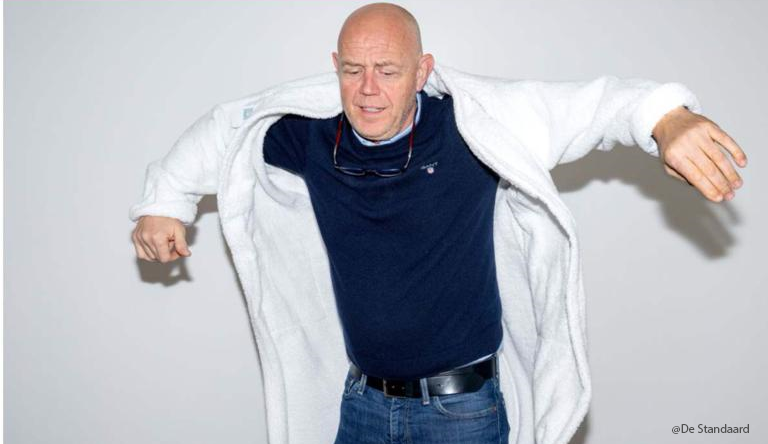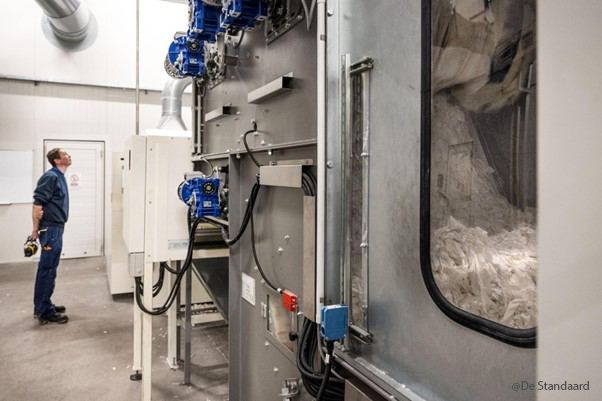Circular fashion has future: 'Recycling cotton is a golden opportunity for Flanders'
Too many clothes, mostly made of petroleum, that become waste too quickly: the fashion industry has gotten stuck in its own low-cost model. In a series about "Fast Fashion: our clothes as disposable products?", De Standaard examines how we can get out of this model. This time they tell the story of Purfi and its impact on the textiles industry.
Whoever can be the first to make new clothing from old textiles has got the holy grail. Flanders is in a strong starting position. Purfi owns a production line that turns old cotton into new fibres and can process 3,000 tonnes of textiles a year. "Our plant runs on solar energy, we use no chemical processes and produce no waste."
Giselle Nath - Saturday 20 January 2024 at 03:00
Pictures by © Fred Debrock
Textile recycling has been a story of 'downcycling' for 30 years. Machines tear apart clothes and compress them into a coarse mat of an indeterminate colour. The end result is no longer wearable: it disappears into, say, a car as soundproofing, or becomes a single-use cleaning cloth. An innovative 160-metre-long installation in Waregem aims to change this.
"What you see here is the coming together of US patented technology and Concordia Textiles' expertise," says manager Koen De Ruyck of Purfi, a Concordia joint venture specialising in cotton recycling. "A new pair of jeans has a cotton fibre of around 30 millimetres. In a classic recycling, you end up with a fibre of 13 mm. Purfi makes fibres of 24 and even 27 millimetres. That length and improved strength make them perfect for new garments."
Concordia Textiles - led by CEO Carl Baekelandt - from which Purfi emerged, will soon celebrate its centenary. This is not obvious, after "the Chinese tsunami of cheap textiles", as De Ruyck puts it. Classic Flemish textile production largely went under in the late 1990s as it delocalised to Asia. But today, big clothing brands - H&M, Tommy Hilfiger, Asics, Decathlon - come knocking on Purfi's door in Waregem. "There is a positive dynamic in the sector again," says De Ruyck.
Reverse Spinning
The European Union has legislation in the pipeline to make fashion more circular. Currently, the model is linear: buy, wear, dump. For the European Commission and Euratex, the European textile industry federation, greening is a matter of simple maths. Europeans throw away 7 to 7.5 million tonnes of clothes every year, only 1 to 0.1 per cent of which become new clothes. If we reuse a quarter of our textile fibres by 2030, that will generate €4.5 billion a year in economic and environmental gains, plus 15,000 European jobs.
That approach becomes even more important as more uncertain cotton harvests (due to climate change) put pressure on traditional supply chains. "Investing now in materials with a low carbon footprint and more resilient supply lines is likely to turn out cheaper than leaving everything as it is," according to news site The Business of Fashion. The Boston Consulting Group even estimates that some 133 tonnes of recycled fibre will be in short supply by 2030 to meet increased demand.
The brutal shredding techniques of the past are not useful for clothing brands. The alternative is to release caustic chemicals on old - often very cheap and unsorted - clothes in a sealed facility. That too is not cost-effective. Purfi is betting on a slow, reverse spinning process that spares the fibre. "Our entire plant runs on solar energy, we don't use chemical processes and produce no waste," says De Ruyck.
Secured by finger
Using air pressure, the machine chases textiles through an elaborate network of tubes on the ceiling. The tubes end behind two closed doors. There sits the machine room, which massages the old fabrics into fluffy, soft balls of cotton via many intermediate steps. "Outsiders are not allowed to see the details of the installation because we have to protect our intellectual property," says De Ruyck. "Only if you were to get your hands on my finger would you be able to look behind those secure doors."
This production line cost more than €8 million. It can process 3,000 tonnes of textiles a year. "This is our unique prototype and we are not selling it," De Ruyck says decidedly. "Two Turkish businessmen recently made an offer, but we are holding off."
Anyone browsing among clothes racks will occasionally find labels saying 'recycled'. De Ruyck makes the case that 95 per cent of that offering is pure greenwashing. "Turkish companies sell yarn labelled Global Recycling Standard. It looks identical to new yarn and costs the same. I have to laugh at that, because that is not technically feasible. A lab can always tell the difference between new and recycled yarn." De Ruyck attaches even less credibility to recycled fibres from China. "There you bring in your old textiles, so to speak, and the very next day they come out with something they call the recycled version."
Multicoloured speckles
Fashion designer Henriette Ernst, a lecturer at the Antwerp Fashion Academy and a specialist in responsible sourcing, can speak for herself. "In Italy, there are many suppliers of fabrics with all kinds of sustainable labels, but if you ask around, it gets more complicated," she says. "Then their fabric with recycled fibres turns out not to be available or not immediately, or only from a certain quantity, or with a different appearance than what we see on site." Supply is small and transparency is lacking.
A recycled cotton T-shirt cannot have the same appearance as a new one, De Ruyck shows using test models. On the recycled white T-shirt there are tiny, multicoloured speckles: these are the remnants of old, dyed fibres.
There should also be a difference between new and recycled fibres in terms of price. "Organising a whole chain to collect, sort and process textiles is much more expensive than buying fresh cotton from a low-wage country," says De Ruyck. So does his product even have a future in a world of cheap fashion? "Brands could take a smaller profit margin on collections with recycled fibres," De Ruyck says directly. "Or Europe could reduce VAT on recycled clothes from 21 to 6 per cent. Those discussions are ongoing at the moment."
European product passport
Europe is already planning concrete measures to tackle the current circus of fake recycling. There is a ban on misleading environmental claims in advertising, and from 2025 clothing brands will have to put a certain percentage of recycled fabric in their collections. How large that proportion should be has not yet been decided.
Europe has also followed the US in banning cotton from China's Xinjiang province, where Uighurs are oppressed. In America, garment companies have to be highly transparent about their supply chain, otherwise those clothes will not get past customs. In Europe, a digital product passport per garment should achieve the same effect. This would include not only information on origin, but also on sustainability. Finally, fashion companies will soon be prohibited from destroying new, unsold products. "All this presents brands with sharper choices," says De Ruyck. "Either fast fashion with 24 collections a year and a big fair at the end, or fewer collections of higher quality. In such a scenario, production and recycling in Europe get another chance."
"What used to be a nice-to-have will become a must-have as a result," he predicts. "French public tenders already require uniforms with recycled yarns, and they demand independent verification on top of that. Apparel will follow that trend. Already, textile waste prices are considerably higher than before. In two years, India and Bangladesh are likely to ban the export and import of textile waste."
In other words, dumping textile waste will become difficult; rather, it will serve again as a raw material. There are several European companies that see opportunities in this. Dutch company Saxcell is working on a deal with large Indian yarn spinners, the Finnish government is putting massive subsidies into Infinited. Those companies use a chemical process to turn old cotton into new fibres. De Ruyck does not feel oppressed by those competitors. "There is plenty of waste, and not everyone is already on the same industrial scale as us. Sometimes it's no more than a machine that can make five kilograms of recycled fibre or have three successful lab tests behind it." He also does not believe that sending old textiles to "a remote corner of Finland" will be profitable.
Self-serving
"For Flanders, with its central location and long expertise in textiles and recycling, a golden opportunity really arrives here. Everyone is starting to know us, everyone wants more. At least four big mainstream brands have already ordered or are about to order a few tonnes of yarn from us."
Everything hinges on the standards that Europe will impose on the industry. "Once we know whether we are going to 20 or 30 per cent recycled material in the collections, brands will have to move," says De Ruyck. "Then things can move fast. But we have to decide now. Europe has no raw materials for textiles: no cotton, no petroleum for polyester. What if India decides one day that less cotton will go to foreign markets? All we have in Europe is that 7 million tonnes of textile waste a year. Surely we are going to have to become a bit more self-sufficient for our clothes."
Find the original Dutch article here: https://www.standaard.be/cnt/dmf20240119_97616847



